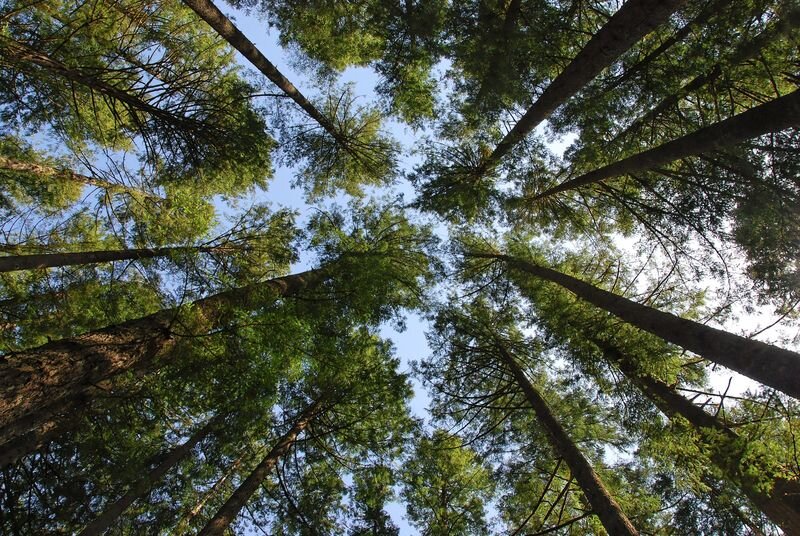Preserving Natural Resources During Landscape Construction – Part 2
Last week, I discussed looking for valuable resources on your site prior to construction. Trees, particularly, add value and permanence to the landscape. They are the largest and longest-lived elements of most landscapes, and can be the largest element lost in it during construction. They also require the greatest area of protection to remain, so they take up what could be “usable” space. If trees are going to be kept on a site, they absolutely require protection in order to survive. Too often no protection or wholly inadequate protection is given, and trees will subsequently decline and die. It can take years for damage to show, so don’t fool yourself if you see a tree still alive after a year or two. Mulch and sod can cover alot, but it doesn’t really fix things. Trees operate on a different time scale than we do, and damage often takes years to fully manifest itself. One of the main things to remember about trees are that the part you see above ground is only half the story. While the above-ground portion needs to be protected from careless treatment and machine operators, the damage that occurs to roots is much more likely to kill them.
What not to do: Cutting through roots in the tree’s root plate will compromise its long term stability.
Tree roots usually extend a great distance from the trunk, far past the “dripline”, with the vast majority of roots in the upper 18 inches of soil. In fact, the tiny, hairy absorptive roots that do most of the work obtaining moisture and minerals are usually in the organic-rich top few inches. Imagine each large root as a river that with many tributaries. All of those roots are flowing mineral-laden water in to support the tissue of the whole organism. These roots require soil, certainly, but too much soil can be damaging; they also require moisture and oxygen in the soil, with the ability for moisture and gases to move through the pores in the soil. Besides cutting of roots leading to root loss, fill soil and compaction disrupt roots’ ability and can kill them as well. Depending on soil types, sometimes even a few inches of fill soil can kill roots. A more important element to remember for safety is that tree roots are what physically hold trees in the soil. There is a zone around the trunk of larger roots that is especially important for anchorage, called the “root plate”. This area varies by tree, site, and species, but the rule of thumb is that the root plate is roughly going to be in a radius from the edge of the trunk 3 times the trunk diameter at breast height from the edge of the trunk.
Compaction from machinery and material storage should not be allowed around trees which are to remain on the site.
Design in mind- reducing footprint
1. After determining the needs and desires of the client for a particular project (and their desire or willingness to work on saving resources) as well as the community requirements, find the necessary expertise to assess the resources on a site, preferably before building and infrastructure siting, if possible. What existing trees, plants, or resources are desirable, and for what reasons? Will it be possible to integrate them into the new landscape? Will there be any conflicts in the future? Accurate mapping and inclusion in plans is critical to success.
2. Where preservation will occur, make it an integral part of the plan from the beginning, and follow through. In design, consider techniques that either protect resources, or integrate creation of infrastructure conducive to restoration. Post and pier construction and cantilevers minimize soil disturbance (though of course, there are limitations for implementation of those), and vertical construction damages less than horizontal. Structural soils, pervious pavers, soil cells, etc. can provide necessary infrastructure while providing opportunity for environmental benefit. For preservation to work, it has to be a part of the process from start to finish. There has to be either one person or a set chain of people who maintain that consistency. Tree locations and protected root zones should be visible on all relevant project plan sheets. Grading, erosion control, foundation, civil, paving, and landscape plans may all impact tree preservation efforts. Notify all the professionals involved in the project that tree and resource preservation is a design goal. Show the protected trees and root zones on all plans to ensure that they are aware of the trees as they complete their work. Set protection zones, pathways for traffic, layouts and material storage and disposal areas, and limits on concrete or chemical debris disposal and tool washing. And remember that these protections can be written into contract language so there is a legal obligation to follow them, as well as set consequences for failure to follow them.
3. Again, a basic tenet of natural resource preservation is minimization of disturbance. Where soils, roots, and waterways are intact, resources are preserved. Of course, this is difficult on construction sites, so identifying areas that can reasonably be protected in the first place is critical. Remember that it’s not just the footprint of the building and entrance, it’s the utilities, sewer/septic, site grading and drainage, compaction from traffic, material lay down, soil storage, chemical spills, and fires, as well as any other activity that encroaches on trees above or below ground, alters the soil, or alters the drainage patterns on a site. Define areas of disturbance and storage, parking areas, etc. before work begins. Specify the process for initial clearing; removing understory plants with a machine is destructive to soils and roots, and grubbing stumps can damage remaining trees. If understory plants are to be removed, consider using either labor and herbicide, or perhaps a mulching head machine (if away from roots of remaining trees). If stumps must be removed, consider using a stump grinder instead of grubbing. If roots are torn, cut them cleanly and cover them as soon as possible.
4. After defining the protection zone, put up sturdy fencing with signs, and keep it in place throughout. The “critical root zone” varies from 10 inches to 1.5 feet of radius per inch of trunk diameter as the minimum. This is not always possible. Where traffic and potential compaction may occur, but the roots are still present in the soil, layers of mulch or gravel covered with sheets of plywood or steel can distribute weight more evenly and reduce compaction. 5. Have a plan for post-construction. Irrigation and soil remediation can help trees recover. And remember that while landscaping can help rehabilitate a site, it too can damage roots. Be prepared for some failure, and try to mitigate as soon as possible.
Michael Davie
ISA Board-Certified Master Arborist
Snow Creek Landscaping, LLC
Books:
James Urban, Up By the Roots- Healthy Soils and Trees in the Built Environment
Nelda Matheny and James R. Clark, Trees and Development: A Technical Guide to Preservation of Trees During Land Development
Laurence R. Costello and Katherine S. Jones, Reducing Tree and Infrastructure Damage by Tree Roots
The Landscape Below Ground- proceedings from the International Workshop on Tree Root Development in Urban Soils
Links:
NC State “Construction and Tree Protection”: www.ces.ncsu.edu/forestry/pdf/ag/ag685.pdf
Sample tree protection language: www.cob.org/documents/parks/development/design-standards/section-4/02231-tree-protection.pdf
USFS Urban and Community Foresty: http://www.fs.fed.us/ucf/
USFS Itree tools: http://www.itreetools.org/
Construction Damage Assessment: Trees and Sites, by Kim Coder, Warnell School of Forest Resources: http://warnell.forestry.uga.edu/warnell/service/library/for96-039a/for96-039a.pdf



